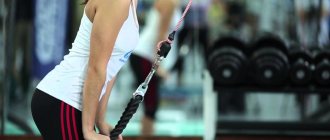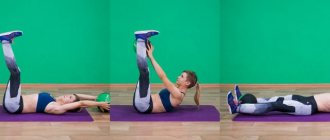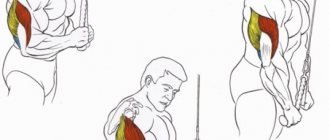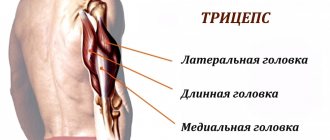Shaped hands are a calling card and an indicator of excellent physical shape in men. Girls are also not averse to “putting things in order” in this area: the lack of muscle tone here spoils the impression even with well-developed buttocks and abs. Effective training of the arms, including triceps, along with basic exercises, should also include isolating movements, for example, extensions on a block.
- Extension of arms on a block: what is the essence of the exercise
- Which muscles get the load?
- The benefits of extensions on the block
- Variability of arm extensions on a block: types of handles
- Classification of standing exercise: extension on a block in different versions
- Classic arm extensions using a lat pulley
- Reverse grip extensions
- Triceps pull-down using a rope handle
- Video: Technique of arm extensions on a vertical (also on the lower) block using different types of handles and grips
- Arm extensions downwards on a block: common mistakes
- How to increase the effectiveness of the triceps crossover press: recommendations
- Video: Triceps superset using extension on a vertical block - execution
Extension of arms on a block: what is the essence of the exercise
To perform this movement, you will need a crossover machine - a block-type power structure, available in almost all gyms. Extension is done on the upper block.
Which muscles get the load?
The main work in this exercise is performed by the triceps - the brachial muscle formed by three bundles: long, lateral and medial. It anatomically passes into a tendon that attaches to the olecranon process of the ulna. The task of the triceps muscle is to extend the forearm at the elbow joint. The long head of the triceps helps drive the shoulder joint.
The triceps accounts for approximately 2/3 of the muscle volume of the shoulder, so this muscle directly affects the definition of the arms.
Static load in extension is received by:
- back muscles (latissimus, teres major, spinal extensors);
- posterior deltoid bundles;
- pectoral muscles;
- lower trapezius area;
- abdominal muscles;
- wrist flexors.
Vertical cable extensions activate all 3 heads of the triceps.
This exercise is isolating because it involves one joint - the elbow. In this regard, it is not recommended to use large weights here: single-joint load distribution leads to distortion of the technique and increases the risk of injury.
The benefits of extensions on the block
An exercise on a vertical block, performed after training with free weights, creates a concentrated load on the triceps, helping to clearly define the muscle relief.
V
The movement on the block is carried out along a given trajectory downwards, which allows you to feel the contraction of the triceps muscle as much as possible.
Extensions can be done in a variety of ways, changing the handles and experimenting with different types of grips. This will allow you to work the target muscles from different angles and avoid a training plateau.
Working out the triceps in a crossover is a suitable option for girls who do not aim to build muscle mass and who want to keep the muscles of the upper arms in good shape.
V
Straight handle lat pulley press
Initial position:
- Stand facing the upper block, slightly bend your knees and lean forward slightly.
- Grasp the straight handle with an overhand grip.
- Elbows pressed to the body.
Performance:
- Keep your back straight and your shoulders back. Inhale powerfully and slowly straighten your elbows.
- At the lowest point of the amplitude, make a distinct pause. Additionally, statically tighten your triceps.
- Slowly return to the starting position.
Recommendations:
- Grab the handle with a shoulder-width grip. If the grip is narrow, the load on the triceps decreases.
- A straight handle puts stress on your wrists, so swap it out for a short curved or V-handle every once in a while for a workout or two.
Variability of arm extensions on a block: types of handles
Before you begin extensions, you need to decide on the choice of handle.
To work the triceps, a short straight handle is often used. With it you can practice with a direct and reverse narrow grip.
To work the triceps on the block, a short straight handle is often used
If there is no short handle in the gym, it is permissible to do extensions with a wide handle - it is usually used for training the back on a vertical block.
Working on the triceps with a wide handle is less convenient, however
For a comfortable position of the hands, it is convenient to use the V-shaped handle.
V-shaped handle allows you to work on the triceps in a comfortable position
Working with a curved handle allows you to position your hands in a special way: the right one in a clockwise direction, and the left one in the opposite direction. In this case, the emphasis of the load will shift to the outer triceps bundle. In addition, the curves on the handle create a more comfortable position for the elbows and reduce stress on this area.
V
You can effectively work the triceps muscle using a rope handle. Here you will have to practice with a neutral grip, so the load on your elbows will be minimal.
According to many athletes, the cable handle works the triceps the best.
If an athlete prefers to perform extensions with each arm in turn, a D-shaped handle will suit him.
V
Not every gym has all the listed types of handles, but the variability of the exercise in question allows you to practice with the equipment that is available: this will not make your training any less effective.
Content
- 1 Purpose of the exercise
- 2 Working muscles
- 3 Technique
Triceps cable pull-down
Triceps cable pull-down for girls
Triceps cable pull-down
In strength training, the triceps pull-down with a cable handle is used as an auxiliary exercise. The movement is actively used not only in bodybuilding and fitness, but also in powerlifting, being an important component of preparation for the bench press. There are several technical versions of this exercise and several nuances to its implementation.
Classification of standing exercise: extension on a block in different versions
You can perform triceps extensions both in a block frame and in a vertical block, traditionally used for back training. The second option is less comfortable for working on the triceps, since the handle in it is fixed high, and there is no possibility of adjusting the height.
Before starting the lesson, select the desired handle, attach it to the upper block and determine the working weight.
Classic arm extensions using a lat pulley
The basic version of triceps extensions is considered to be training using a straight handle, which is taken with a straight (overhead) grip slightly narrower than shoulder width. This grip will allow you to effectively work out the medial and lateral heads of the triceps muscle.
Positioned facing the device, take the handle and lower it until a right angle is formed between the shoulder and forearm. The body is kept level, slightly tilted forward, with a fixed natural arch in the back. One foot can be placed slightly in front of the other for greater stability. The chest is straightened, the elbows are kept in close proximity to the body.
- Inhaling, with a uniform force of the triceps, move the handle to the bottom until the arms are completely straightened. The most difficult part of the movement is done while exhaling. Only your forearms should move.
- At the lowest point, the handle almost touches the hips. Here they stop for 1–2 seconds, further contracting the muscles being worked.
- With a controlled and slow movement, resisting inertia, while inhaling we go up to the original position.
Do 15 times in 3 approaches.
V
Reverse grip extensions
Unlike the “classics”, here the handle is taken with an underhand grip. This method is used if you need to shift the emphasis of the load to the long head of the triceps.
When working with a reverse grip, a significant load is placed on the hands, especially the thumbs: when they are not strong enough, the handle can slip out. If this method of performing extensions is important to an athlete, for better training it makes sense to additionally strengthen the hands with special exercises.
The main movements in this exercise are done similarly to classic extensions on a block.
V
Experienced athletes who train triceps on a pulley with a reverse grip often perform this exercise with each hand in turn, using a D-shaped handle. This technique allows you to slightly turn your hands, working in a more comfortable position.
V
Triceps pull-down using a rope handle
The rope, or rope handle, due to its flexible structure makes it possible to isolate the work of the triceps muscle as much as possible and ensures its powerful contraction.
When exercising with such a device, the athlete makes movements with greater amplitude, activating the deepest fibers of the triceps.
Having decided on the weight and securing the rope handle to the upper block, they are positioned facing the simulator. This exercise uses a neutral grip: the wrists are in an anatomically natural position, and the thumbs are facing each other.
- Inhaling, as you exhale, begin to straighten your arms at the elbow joints, moving the handle towards the front of your thighs.
- At the bottom, your palms should be facing back and your thumbs should be facing your hips. To increase the working amplitude, the arms below are moved slightly to the sides. Here you need to stop for 1-2 counts, straining your triceps.
- As you inhale, take the initial position with a controlled movement.
Do 12–15 repetitions in 3 sets.
V
Video: Technique of arm extensions on a vertical (also on the lower) block using different types of handles and grips
Arm extensions downwards on a block: common mistakes
A simple movement in a block simulator is often performed with poor technique. This reduces the effectiveness of the exercise and makes it dangerous.
- Incorrect position of the body: an absolutely level position (excessive activation of the abdominal and back muscles will not allow the triceps to be properly loaded) or a slouch (in this case the spine suffers).
- Very close or far distance to the block. In the first case, the execution technique will be violated, in the second, the lower back will receive excessive load. The ideal distance is about half a meter from the simulator.
- Moving the elbows away from the body to the sides or forward. In this situation, the triceps do not receive full development, since the emphasis of the load is partially shifted to the deltoids and back muscles.
- “Throwing” the hands back to the starting position. This movement is done more slowly than extension, while maintaining muscle tension.
- Pull the handle down using the back muscles. The exercise in this version loses its meaning, since the role of the triceps here is secondary.
- Jerky movements and the inclusion of inertia in the work.
- Sitting extensions. This technique is undesirable: this exercise should be performed while standing, otherwise the load is not distributed quite correctly.
- The use of excessive weights, leading to disruption of technique and activation of other muscle masses.
V
The correct extension technique on a block involves isolated activation of the triceps muscles (not counting the muscles working statically). If, at the end of the set, fatigue is felt in other muscle groups, the movement was done incorrectly.
Peculiarities
- The simulators must use special types of cables that correspond to the specific load.
Under the influence of the loads of the weight system and due to frequent bending when moving along the roller, the cable experiences heavy loads. For this reason, conventional cables sold for simple lifting of weights cannot withstand loads of this kind and quickly become unusable.
- Self-made block exercise machines that do not take into account the need to install cables on them that correspond to the characteristics of the load can be dangerous for trainees, especially with sudden, jerking movements used when trying to overcome heavy weights. This is especially true for a vertical traction machine.
- When operating such cables, high-quality crimping fittings that prevent them from twisting and the presence of internal lubrication are of great importance.
- Braiding helps protect the cable from damage caused by bending. The durability of the cable largely depends on its quality. A braid that is too rigid and does not bend well will quickly become unusable at the point of contact with the roller and lead to damage to the metal part of the cable.
- For safety reasons during operation, it is necessary to regularly inspect the cables, because Usually the cable does not break immediately, but after several small breaks in the threads. Particular attention should be paid to the sections of the cable in contact with the rollers.
- One of the causes of damage during operation may be improper fastening of the tip to the cable (at an angle). In this case, the tip can cut the cable with its sharp part. This aspect also needs to be paid attention to when purchasing.
According to modern safety requirements, the connection between the cable and the pulley in the simulator must be protected by a cover. This prevents dangerous contact with the user.
How to increase the effectiveness of the triceps crossover press: recommendations
The movement in question will fit perfectly into a triceps training plan as a final exercise. It will complement the basic program for the development of this muscle (close-grip bench press, dips).
Since the target muscle is already tired after heavy basic training, you should not use heavy weights in extensions on the block. It is better to work in a high-repetition mode with medium weights, performing 15–20 repetitions per set.
V
Those who prefer to train using a superset system, including the French press (performing exercises one after another without pauses for rest), can use extensions, combining them in series with multi-joint movements. It is recommended to use the basic exercise as the first exercise in the set, and then continue the exercise, moving to the crossover. Such series can consist of exercises for one muscle group or for the development of antagonist muscles (triceps-biceps).
Video: Triceps superset using extension on a vertical block - execution
When training in a block machine, you can quickly and easily change the working weight. This feature is used when doing extensions according to the “pyramid” principle: several approaches follow one after another without rest with sequential weight loss.
Experienced athletes use this exercise as a movement to pre-exhaust the triceps muscle before a basic program, as well as to warm up.
Extension of the arms on the upper block is an isolating movement that will not replace multi-joint exercises for the development of triceps, but in combination with basic exercises will increase the effectiveness of the training. The result of including extensions in the training plan will be an attractive relief of the arms with clearly defined triceps.
Triceps overhead presses in your program
- All variations of presses are suitable for opening triceps training. Presses warm up the elbow joints well without overloading them. After bench presses, you can safely move on to complex exercises such as standing and lying French presses. By the way, it is worth completing the training of the triceps with bench presses in order to bring them to the point of complete “switching off”. For final presses, a cable handle is more suitable.
- If you are going to train your triceps in the same workout as your pecs or deltoids, first deal with these muscles, and only then tackle the triceps. The fact is that the pectorals and deltoids work together with the triceps in all exercises. Tired triceps will not allow you to load them to their full potential.
- For the same reason, do not train your pecs and deltoids the day after training your triceps. During the night, the triceps will not be able to recover, and the exercises on the pectoral and deltoids will be half-hearted.
- To ensure that all triceps bundles receive their portion of the load, regularly change the handles when performing downward presses.
- If you really don't have time, do two sets of cable, straight, and V-handle presses. This is enough to maintain high triceps tone.
531 5








